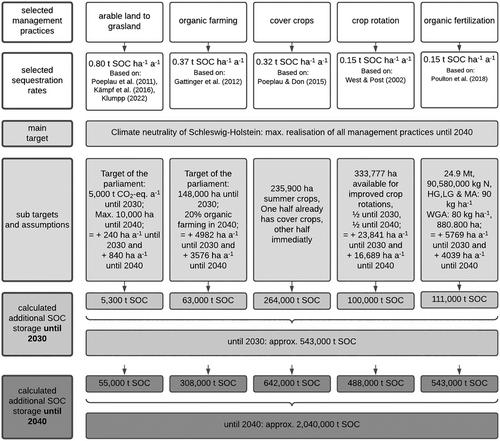Soil Organic Carbon (SOC) Stocks of Mineral Arable Soils in Schleswig-Holstein and Their Future Carbon Storage Potential
Abstract
Background
Agricultural soils have the potential for long-term carbon sequestration by building up and maintaining soil organic carbon (SOC) to mitigate climate crisis. Organic soils under grassland use are often highlighted in this regard. However, given that approximately two-thirds of Schleswig-Holstein's (SH's) (Northern Germany) agriculturally used area is classified as arable land, these large areas have a potential for additional carbon storage, too.
Aims
The aim is to determine the current SOC stocks of mineral arable soils in SH and derive additional carbon storage potentials based on these data to predict additional storage potentials for the main soil type groups and geological regions. Additionally, we aim to identify the most promising agricultural practices in arable farming to exploit these potentials.
Methods
Soil data from mineral arable sites in SH were compiled, and current carbon stocks were calculated at depths of 0–30 cm and 30–100 cm. A new method (the median method) to predict additional SOC storage potentials was developed. To evaluate management practices for enhancing SOC stocks and exploit the calculated storage potentials, an optimized scenario was designed.
Results
The mean calculated SOC stocks of mineral arable soils in SH are 113 t SOC ha−1 (1 m) or 71 t SOC ha−1 (30 cm). The additional SOC storage potential in the topsoil (30 cm) of the total area of 9.1 Mt SOC was calculated, that is, an average potential of 13 t SOC ha−1. The scenario with five promising management practices showed that the predicted storage potential of the topsoil could be utilized by 6% in 2030 and 21% in 2040. It will take until 2090 to fully exploit the calculated potential.
Conclusions
The soils in SH show slightly higher SOC stocks and lower SOC storage potentials compared to other studies. These differences are due to variations in climate and parent material (especially marshlands), as well as the inherent limitations of the median method, which is a robust but potentially underestimating approach. It can be concluded that the exploitation of the calculated storage potentials can only be achieved through a comprehensive and long-term implementation of management practices.


 求助内容:
求助内容: 应助结果提醒方式:
应助结果提醒方式:


